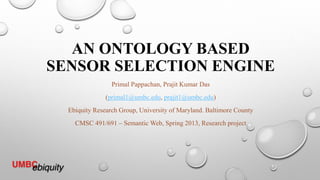
An ontology based sensor selection engine
- 1. AN ONTOLOGY BASED SENSOR SELECTION ENGINE Primal Pappachan, Prajit Kumar Das (primal1@umbc.edu, prajit1@umbc.edu) Ebiquity Research Group, University of Maryland. Baltimore County CMSC 491/691 – Semantic Web, Spring 2013, Research project
- 2. Motivation • Standardize the sensor readings from mobile devices using semantic web technologies. • Provide a semantic interface to the sensor data so as to improve understandability and reusability as well as easier for developer access. • Create a knowledge base of sensors, their capabilities, accuracy score and power efficiency rating. • Identify sensor groups which can provide the same type of data but with differing accuracy and power requirements. • Quantify and codify differences in sensor readings associated with various user activities. • Make it possible to have a fine grained understanding of user context and optimize sensor usage based on the same so as to save the phone battery. • Correlate locations and sensor readings with place labels based on the user activity.
- 3. What we are trying to achieve
- 4. Use Cases • Alice is at home and sleeping in her bedroom in the night. Using Wi-Fi fingerprinting the mobile knows she is at home. The sensor probes detect no audio, no screen actions and no accelerometer reading and therefore infers that she is sleeping. Annotates the corresponding readings with activity as sleeping and place as bedroom. Turns off all sensors to save battery. Next time user is in the same room at same time with similar kind of sensor readings, previous action is taken automatically. • Bob goes to the university on week days at 9 am and is in the same building until 4 pm on these days and attends classes and meetings. Based on similar sensor readings on weekdays between afore-mentioned time period, system can choose a particular combination of sensors based on the capability group, required accuracy of the requesting Apps and power efficiency rating for that time of day in the week.
- 5. High Level System Architecture Applications Android Framework Wi-Fi Fingerprinting Sensor Probes Knowledge Base Inference Engine Sensor Manager Service User Activity Input Sensor Manager Middleware
- 6. Tools of the trade
- 8. Roadmap to the goal • Extend the existing Platys ontology using OWL 2 Activity Ontology to represent association between a location and an activity. • Use tagin! to mark indoor locations with Wi-Fi fingerprinting and use funf in a box to collect sensor data. • Create a sensor ontology to define sensor capability groups, efficiency ratings and accuracy score. • Develop App to collect user activity tags and associate tags with location. • Generate the rules for the inference engine. • Combine the modules into a middleware which will control the context data flow on the mobile.
- 9. References & Acknowledgement [1] Zavala, Laura, et al. “Mobile, Collaborative, Context-Aware Systems.” Proc. AAAI Workshop on Activity Context Representation: Techniques and Languages, AAAI. AAAI Press. 2011. [2] Nath, Suman. “Ace: exploiting correlation for energy-efficient and continuous context sensing.” Proceedings of the 10th international conference on Mobile systems, applications, and services. ACM, 2012. [3] http://xmlns.com/foaf/spec/ [4] Zhu, Yin, et al. “Feature engineering for place category classification.” Mobile data challenge (by Nokia) workshop, June. 2012. [5] Korpipää, Panu, and Jani Mäntyjärvi. “An ontology for mobile device sensor-based context awareness.” Modeling and Using Context. Springer Berlin Heidelberg, 2003. 451-458. [6] When will your phone battery last as long as your kindle? - http://www.digitaltrends.com/mobile/feel-the-power-the-future-of-smartphone-batteries/ [7] tagin! - Open source, location tagging engine http://wiki.mobile-accessibility.idrc.ocad.ca/w/Tagin! [8] http://www.sciencedirect.com/science/article/pii/S1574119211000265 [9] http://www.digitaltrends.com/mobile/feel-the-power-the-future-of-smartphone-batteries/ • This research was partially supported by the national science foundation (award 0910838) and the air force office of scientific research (grant FA550-08-0265). Dr. Anupam Joshi, Dr. Tim Finin Under the guidance of : Follow me on twitter: @primpopWebsite: http://primux.in
